Assimilation of SMAP Products for Improving Streamflow Simulations over Tropical Climate Region—Is Spatial Information More Important Than Temporal Information?
Abstract
:1. Introduction
| References | Climate Region | Catchments/RS SM Datasets | DA(*)/Hydrological Models (**) | Main Findings |
|---|---|---|---|---|
| Jadidoleslam et al., 2021 [37] | Cold | 131/ SMAP, SMOS | EnKF, EnKFV/ HLM | DA driven models reduce the peak error and could be useful for the application of satellite soil moisture for operational real-time streamflow forecasting. |
| Abbaszadeh et al., 2020 [13] | Temperate | 4/ SMAP | EPFM/ WRF-Hydro | Assimilation of SM could improve streamflow simulation during flooding from hurricane Harvey in 2017, with a promising result from SM at 1 km. |
| Baguis et al., 2017 [51] | Temperate | 1/ ASCAT | EnKF/ SCHEME | The DA algorithm could be a diagnostic tool to detect weakness in a model and to improve its performance. |
| Patil and Ramsankaran, 2018 [14] | Temperate | 2/ SMOS, ASCAT | EnKF/ SWAT | A coupling Soil Moisture Analytical Relationship with EnKF could successfully update the sub-surface SM and streamflow components simulation. |
| Laiolo et al., 2016 [20] | Temperate | 1/ EUMET-SAT H-SAF, SMOS | Nudging/Continuum | Streamflow prediction for a small basin using a distributed hydrological model could be improved with the assimilation of soil moisture estimated from coarse spatial resolution remotely sensed products. |
| Behera et al., 2019 [15] | Tropical | 1/ AMSR-E | Kalman Filter/VIC | DA driven models could improve soil moisture in root zone and water balance estimation. |
| Azimi et al., 2020 [36] | Temperate | 2/ SMAP, SACAT, CATSAR-SWI | EnKF/ SWAT | Both active and passive-based SM driven simulation generally improved streamflow simulation. The impact of frequency of soil moisture observation on data assimilation performances in small catchments was discussed. |
| Lü et al., 2016 [52] | Arid | 2/ ASCAT | EnKF/ HBV | A combined surface soil moisture and snow depth data assimilation into a hydrological model was proposed to improve streamflow estimation in cold and warm season headwater watersheds. |
| Yang et al., 2021 [31] | Temperate | 3/ ESA CCI, SMAP | EnKF/ DDRM | Assimilation of soil moisture products in high spatial gridded modelling could increase DA performances in terms of simulating profile soil moisture. |
| De Santis et al., 2021 [38] | Cold, Temperate | 775/ ESA CCI | EnKF/ MISDc-2L | An assessment of large-scale DA experiments in hydrological model streamflow simulation was carried out over Europe. This study also considered impacts of vegetation density, topographical complexity and basin area on the DA performances. |
| Loizu et al., 2018 [53] | Temperate | 2/ ASCAT | EnKF/ MISDc, TOPLATS | This study examined the impacts of three different re-scaling techniques on SM data assimilation for two hydrological models. A careful evaluation for observation error and re-scaling technique is recommended for successful implementation of a data assimilation framework. |
2. Materials and Methods
2.1. Catchment Sites and Its Streamflow Observations
2.2. Climatic Datasets
2.2.1. GPM IMERG Precipitation
2.2.2. NCEP CFSR V2 Air Temperature
2.3. Remotely Sensed Soil Moisture Datasets
2.3.1. Soil Moisture Active Passive
2.3.2. Downscaled Soil Moisture Active Passive
3. Methodology
3.1. Principle of the Hydrological SWAT Model in Streamflow Simulation
3.2. Setup the Hydrological SWAT Model
3.3. Data Assimilation—Ensemble Kalman Filter (EnKF)
3.3.1. Bias Correction of Observed SM and Ensembles Generation
3.3.2. EnKF Algorithm
3.4. Streamflow Performance Metrics
- is the Pearson correlation coefficient, reflecting the error in shape and timing between observed and simulated streamflow.
- is the bias term, evaluating the bias between observed and simulated streamflow.
- is the ratio between coefficients of variation in observed and simulated streamflow, assessing the flow variability error with bias consideration.
- -
- Normal streamflow time series (hereafter ), to have more weights on high flow.
- -
- Square root streamflow time series (hereafter ), to have more weights on average flow.
- -
- Inverse streamflow time series (hereafter ), to have more weights on low flow.
4. Results and Discussion
4.1. Characteristics of Soil Moisture SMAP Products
4.2. Performances of Deterministic Hydrological SWAT Model in Simulating Streamflow
4.3. Temporal Variation for Open Loop, EnKF-SM9, and EnKF-SM1
4.4. Statistical Performances for Data Assimilation with SM9 and SM1
4.5. Assessment of Factors Impact on DA Performances
5. Conclusions and Further Study
Supplementary Materials
Author Contributions
Funding
Institutional Review Board Statement
Informed Consent Statement
Data Availability Statement
Acknowledgments
Conflicts of Interest
Appendix A
| Types | Data Description | Spatial Resolution | gvo | aho | bye | slu | chu | gso | nkh | xla |
|---|---|---|---|---|---|---|---|---|---|---|
| Benhai River | Trakhuc River | Namnua River | Luy River | LucNam River | Krong Ana River | Hieu River | Ma River | |||
| Area (km2) | 267 | 383 | 638 | 964 | 2090 | 3100 | 4024 | 6430 | ||
| Dry Season/Wet Season | I–VIII/ IX–XII | I–VIII/ IX–XII | XI–IV/ V–X | XI–IV/ V–X | XI–IV/ V–X | XII–IV/ V–XI | XII–V/ VI–XI | XI–IV/ V–X | ||
| Precipitation (unit in mm) | IMERG Final v6 | ~10 km | 1911 | 2165 | 1644 | 1577 | 1807 | 1798 | 1755 | 1629 |
| Potential Evapotranspiration (unit in mm) | Hargreaves method with data from CFSR vs2 | ~25 km | 1024 | 849 | 1051 | 788 | 1258 | 1223 | 1018 | 1402 |
| Digital Elevation (DEM) (unit in m) | HydroSHEDs | 90 m | Min: 10 | Min: 19 | Min: 470 | Min: 25 | Min: 7 | Min: 407 | Min: 33 | Min: 282 |
| Max: 1213 | Max: 1008 | Max: 1736 | Max: 1747 | Max: 1003 | Max: 2407 | Max: 2416 | Max: 2164 | |||
| Mean: 215 | Mean: 366 | Mean: 945 | Mean: 451 | Mean: 248 | Mean: 658 | Mean: 396 | Mean: 958 | |||
| Land use * | MODIS12Q1 | 500 m | FRSE (50.36) | FRSE (67.10) | FRSE (32.07) | FRSE (46.15) | SHRB (70.67) | CRGR (41.10) | SHRB (45.94) | SHRB (75.97) |
| SHRB (47.18) | SHRB (31.31) | SHRB (63.75) | CRGR (18.02) | FRSE (27.84) | SHRB (30.04) | FRSE (42.85) | FRSE (18.44) | |||
| SHRB (16.97) | FRSE (26.51) | |||||||||
| FRSD (11.5) | ||||||||||
| Soil ** | HWSD | 1 km | Ao (100) | Ao (98.67) | Ao (100) | Ao (77.26) | Ao (92.95) | Fr (39.62) | Ao (98.85) | Ao (100) |
| Lc (18.64) | Af (5.58) | Af (30.21) | ||||||||
| Ao (30.09) | ||||||||||
| Sub-basins, HRUs | 10% soil, 10% land use, 10% slope | 5 sub-basins | 9 sub-basins | 9 sub-basins | 17 sub-basins | 35 sub-basins | 59 sub-basins | 91 sub-basins | 125 sub-basins | |
| 24 HRUs | 50 HRUs | 60 HRUs | 116 HRUs | 186 HRUs | 314 HRUs | 590 HRUs | 579 HRUs |
| Parameter Name | Units | Description | Default | Range | Process |
|---|---|---|---|---|---|
| R_CN2.mgt | none | SCS runoff curve number | HRU specific | −0.25, +0.25 | Surface Runoff |
| V_SURLAG.bsn | none | Surface runoff lag time | 4 | 0.05, +24 | Surface Runoff |
| R_HRU_SLP.hru | m/m | Average slope steepness | 0.217 | −0.25, +0.25 | Surface Runoff |
| V_GW_REVAP.gw | none | Groundwater “revap” coefficient | 0.02 | 0.02, +2 | Evapotranspiration |
| V_ESCO.hru | none | Soil evaporation compensation factor | 0.95 | 0, +1 | Evapotranspiration |
| V_CH_N2.rte | none | Manning’s “n” value for the main channel | 0.014 | 0, +0.3 | Channel |
| V_CH_K2.rte | mm/hour | Effective hydraulic conductivity in main channel alluvium | 0 | 0, +500 | Channel |
| R_SOL_AWC(..).sol | mm H2O/mm soil | Available water capacity of the soil layer | 0.1112 | −0.25, +0.25 | Soil |
| R_SOL_K(..).sol | mm/hour | Saturated hydraulic conductivity | 7.113 | −0.25, +0.25 | Soil |
| V_ALPHA_BF.gw | days | Base flow alpha factor | 0.048 | 0, +1 | Groundwater |
| V_GW_DELAY.gw | days | Groundwater delay | 31 | 0, +500 | Groundwater |
| V_GWQMN.gw | mm H2O | Threshold depth of water in the shallow aquifer required for return flow to occur | 1000 | 0, +5000 | Groundwater |
| V_RCHRG_DP.gw | None | Deep aquifer percolation fraction | 0.05 | 0, +1 | Groundwater |
| Perturbation Variables | Description | Range |
|---|---|---|
| Observed soil moisture | Observed soil moisture coefficient | 50–200 |
| Precipitation | Precipitation error coefficient | 0.1–1.0 |
| Field capacity for soil layer 1 | Field capacity for soil layer 1 coefficient | 0.1-0.3 |
| Field capacity for soil layer 2 | Field capacity for soil layer 2 coefficient | 0.05–0.2 |
| Field capacity for soil layer 3 | Field capacity for soil layer 3 coefficient | 0.01–0.1 |
| Soil moisture layer 1 | Soil moisture error standard deviation for layer 1 | 0.01–0.1 |
| Soil moisture layer 2 | Soil moisture error standard deviation for layer 2 | 0.01–0.1 |
| Soil moisture layer 3 | Soil moisture error standard deviation for layer 3 | 0.01–0.1 |
| Curve number | Curve number error standard | 1–5 |

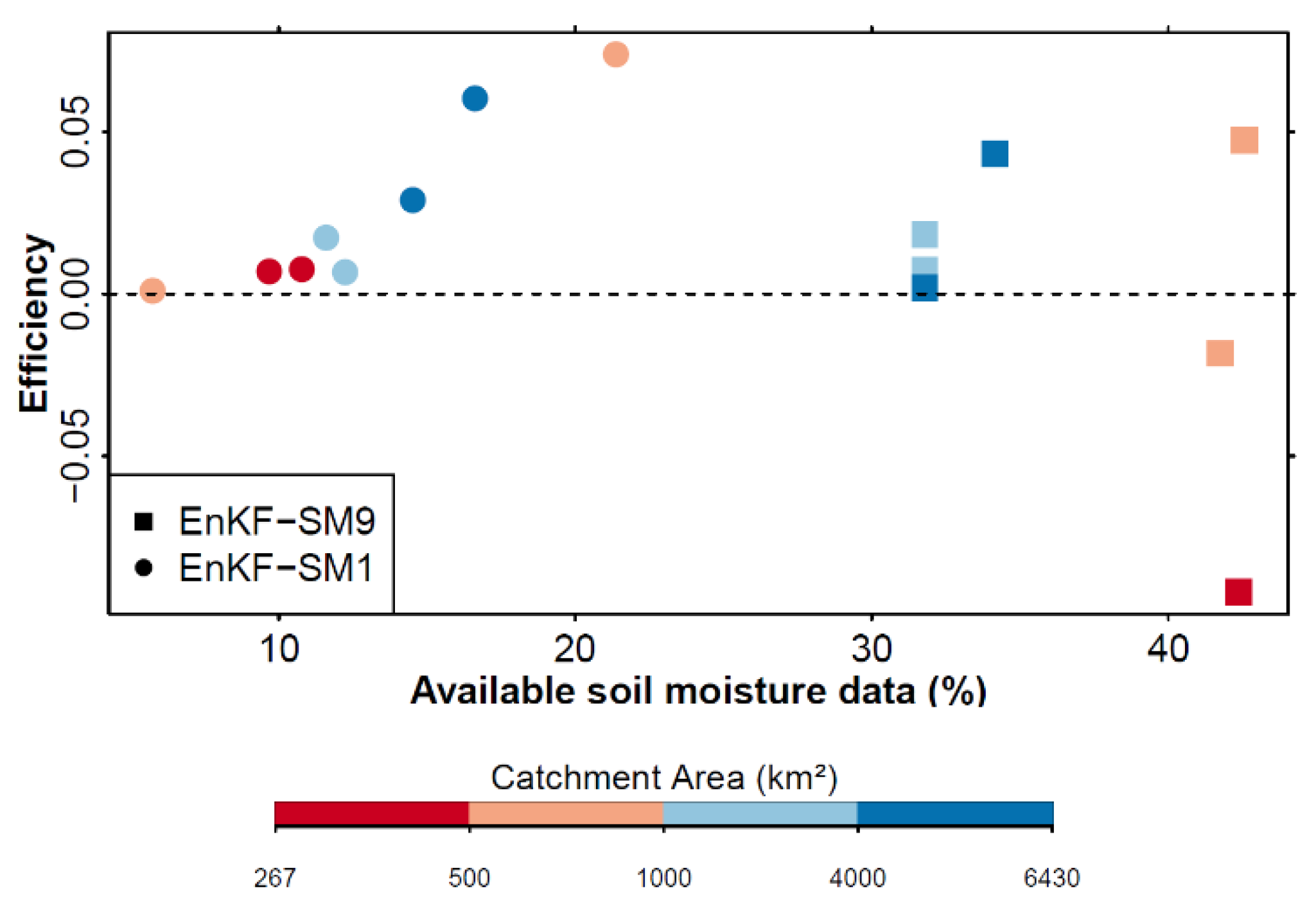
References
- Ahmad, S.; Kalra, A.; Stephen, H. Estimating soil moisture using remote sensing data: A machine learning approach. Adv. Water Resour. 2010, 33, 69–80. [Google Scholar] [CrossRef]
- Western, A.W.; Grayson, R.B.; Blöschl, G. Scaling of Soil Moisture: A Hydrologic Perspective. Annu. Rev. Earth Planet. Sci. 2002, 30, 149–180. [Google Scholar] [CrossRef] [Green Version]
- Grayson, R.B.; Western, A.W.; Chiew, F.H.S.; Bloschl, G. Preferred states in spatial soil moisture patterns: Local and nonlocal controls. Water Resour. Res. 1997, 33, 2897–2908. [Google Scholar] [CrossRef]
- Sheikh, V.; Visser, S.; Stroosnijder, L. A simple model to predict soil moisture: Bridging Event and Continuous Hydrological (BEACH) modelling. Environ. Model. Softw. 2009, 24, 542–556. [Google Scholar] [CrossRef]
- Kim, H.; Parinussa, R.; Konings, A.G.; Wagner, W.; Cosh, M.H.; Lakshmi, V.; Zohaib, M.; Choi, M. Global-scale assessment and combination of smap with ascat (active) and amsr2 (passive) soil moisture products. Remote Sens. Environ. 2018, 204, 260–275. [Google Scholar]
- Kim, S.; Zhang, R.; Pham, H.; Sharma, A. A Review of Satellite-Derived Soil Moisture and Its Usage for Flood Estimation. Remote Sens. Earth Syst. Sci. 2019, 2, 225–246. [Google Scholar] [CrossRef]
- Dorigo, W.; Himmelbauer, I.; Aberer, D.; Schremmer, L.; Petrakovic, I.; Zappa, L.; Preimesberger, W.; Xaver, A.; Annor, F.; Ardö, J.; et al. The International Soil Moisture Network: Serving Earth system science for over a decade. Hydrol. Earth Syst. Sci. 2021, 25, 5749–5804. [Google Scholar] [CrossRef]
- Bartalis, Z.; Wagner, W.; Naeimi, V.; Hasenauer, S.; Scipal, K.; Bonekamp, H.; Figa, J.; Anderson, C. Initial soil moisture retrievals from the METOP-A Advanced Scatterometer (ASCAT). Geophys. Res. Lett. 2007, 34, 34. [Google Scholar] [CrossRef] [Green Version]
- Kerr, Y.H.; Waldteufel, P.; Wigneron, J.P.; Martinuzzi, J.; Font, J.; Berger, M. Soil moisture retrieval from space: The Soil Moisture and Ocean Salinity (SMOS) mission. IEEE Trans. Geosci. Remote Sens. 2001, 39, 1729–1735. [Google Scholar] [CrossRef]
- Kawanishi, T.; Sezai, T.; Ito, Y.; Imaoka, K.; Takeshima, T.; Ishido, Y.; Shibata, A.; Miura, M.; Inahata, H.; Spencer, R. The advanced microwave scanning radiometer for the earth observing system (AMSR-E), NASDA’s contribution to the EOS for global energy and water cycle studies. IEEE Trans. Geosci. Remote Sens. 2003, 41, 184–194. [Google Scholar] [CrossRef]
- Imaoka, K.; Kachi, M.; Fujii, H.; Murakami, H.; Hori, M.; Ono, A.; Igarashi, T.; Nakagawa, K.; Oki, T.; Honda, Y.; et al. Global Change Observation Mission (GCOM) for Monitoring Carbon, Water Cycles, and Climate Change. Proc. IEEE 2010, 98, 717–734. [Google Scholar]
- Entekhabi, D.; Njoku, E.G.; O’Neill, P.E.; Kellogg, K.H.; Crow, W.T.; Edelstein, W.N.; Entin, J.K.; Goodman, S.D.; Jackson, T.J.; Johnson, J.; et al. The Soil Moisture Active Passive (SMAP) Mission. Proc. IEEE 2010, 98, 704–716. [Google Scholar] [CrossRef]
- Abbaszadeh, P.; Gavahi, K.; Moradkhani, H. Multivariate remotely sensed and in-situ data assimilation for enhancing community WRF-Hydro model forecasting. Adv. Water Resour. 2020, 145, 103721. [Google Scholar] [CrossRef]
- Patil, A.; Ramsankaran, R. Improved streamflow simulations by coupling soil moisture analytical relationship in EnKF based hydrological data assimilation framework. Adv. Water Resour. 2018, 121, 173–188. [Google Scholar] [CrossRef]
- Behera, S.S.; Nikam, B.R.; Babel, M.S.; Garg, V.; Aggarwal, S.P. The Assimilation of Remote Sensing-Derived Soil Moisture Data into a Hydrological Model for the Mahanadi Basin, India. J. Indian Soc. Remote Sens. 2019, 47, 1357–1374. [Google Scholar] [CrossRef]
- Patil, A.; Ramsankaran, R. Improving streamflow simulations and forecasting performance of SWAT model by assimilating remotely sensed soil moisture observations. J. Hydrol. 2017, 555, 683–696. [Google Scholar] [CrossRef]
- Sazib, N.; Bolten, J.; Mladenova, I. Exploring Spatiotemporal Relations between Soil Moisture, Precipitation, and Streamflow for a Large Set of Watersheds Using Google Earth Engine. Water 2020, 12, 1371. [Google Scholar] [CrossRef]
- Bolten, J.D.; Crow, W.; Zhan, X.; Jackson, T.J.; Reynolds, C.A. Evaluating the Utility of Remotely Sensed Soil Moisture Retrievals for Operational Agricultural Drought Monitoring. IEEE J. Sel. Top. Appl. Earth Obs. Remote Sens. 2010, 3, 57–66. [Google Scholar] [CrossRef] [Green Version]
- Mladenova, I.E.; Bolten, J.D.; Crow, W.T.; Sazib, N.; Cosh, M.H.; Tucker, C.J.; Reynolds, C. Evaluating the Operational Application of SMAP for Global Agricultural Drought Monitoring. IEEE J. Sel. Top. Appl. Earth Obs. Remote Sens. 2019, 12, 3387–3397. [Google Scholar] [CrossRef]
- Laiolo, P.; Gabellani, S.; Campo, L.; Silvestro, F.; Delogu, F.; Rudari, R.; Pulvirenti, L.; Boni, G.; Fascetti, F.; Pierdicca, N.; et al. Impact of different satellite soil moisture products on the predictions of a continuous distributed hydrological model. Int. J. Appl. Earth Obs. Geoinf. 2016, 48, 131–145. [Google Scholar] [CrossRef]
- Matgen, P.; Fenicia, F.; Heitz, S.; Plaza, D.; de Keyser, R.; Pauwels, V.R.; Wagner, W.; Savenije, H. Can ASCAT-derived soil wetness indices reduce predictive uncertainty in well-gauged areas? A comparison with in situ observed soil moisture in an assimilation application. Adv. Water Resour. 2012, 44, 49–65. [Google Scholar] [CrossRef]
- Han, X.; Li, X.; Franssen, H.J.H.; Vereecken, H.; Montzka, C. Spatial horizontal correlation characteristics in the land data assimilation of soil moisture. Hydrol. Earth Syst. Sci. 2012, 16, 1349–1363. [Google Scholar] [CrossRef] [Green Version]
- Narayan, U.; Lakshmi, V. Characterizing subpixel variability of low resolution radiometer derived soil moisture using high resolution radar data. Water Resour. Res. 2008, 44. [Google Scholar] [CrossRef] [Green Version]
- Narayan, U.; Lakshmi, V.; Jackson, T. High-resolution change estimation of soil moisture using L-band radiometer and Radar observations made during the SMEX02 experiments. IEEE Trans. Geosci. Remote Sens. 2006, 44, 1545–1554. [Google Scholar] [CrossRef]
- Fang, B.; Lakshmi, V.; Bindlish, R.; Jackson, T.J.; Cosh, M.; Basara, J. Passive microwave soil moisture downscaling using vegetation index and skin surface temperature. Vadose Zone J. 2013, 12, vzj2013.05.0089. [Google Scholar] [CrossRef]
- Fang, B.; Lakshmi, V.; Bindlish, R.; Jackson, T.J. Downscaling of SMAP Soil Moisture Using Land Surface Temperature and Vegetation Data. Vadose Zone J. 2018, 17, 170198. [Google Scholar] [CrossRef] [Green Version]
- Fang, B.; Lakshmi, V.; Bindlish, R.; Jackson, T.J.; Liu, P.-W. Evaluation and validation of a high spatial resolution satellite soil moisture product over the Continental United States. J. Hydrol. 2020, 588, 125043. [Google Scholar] [CrossRef]
- Fang, B.; Lakshmi, V.; Jackson, T.J.; Bindlish, R.; Colliander, A. Passive/active microwave soil moisture change disaggregation using SMAPVEX12 data. J. Hydrol. 2019, 574, 1085–1098. [Google Scholar] [CrossRef]
- Busch, F.A.; Niemann, J.D.; Coleman, M. Evaluation of an empirical orthogonal function-based method to downscale soil moisture patterns based on topographical attributes. Hydrol. Process. 2011, 26, 2696–2709. [Google Scholar] [CrossRef]
- Ranney, K.J.; Niemann, J.D.; Lehman, B.M.; Green, T.R.; Jones, A.S. A method to downscale soil moisture to fine resolutions using topographic, vegetation, and soil data. Adv. Water Resour. 2015, 76, 81–96. [Google Scholar] [CrossRef] [Green Version]
- Yang, H.; Xiong, L.; Liu, D.; Cheng, L.; Chen, J. High spatial resolution simulation of profile soil moisture by assimilating multi-source remote-sensed information into a distributed hydrological model. J. Hydrol. 2021, 597, 126311. [Google Scholar] [CrossRef]
- Bai, J.; Cui, Q.; Zhang, W.; Meng, L. An Approach for Downscaling SMAP Soil Moisture by Combining Sentinel-1 SAR and MODIS Data. Remote Sens. 2019, 11, 2736. [Google Scholar] [CrossRef] [Green Version]
- Fang, B.; Lakshmi, V.; Cosh, M.; Liu, P.; Bindlish, R.; Jackson, T.J. A global 1-km downscaled SMAP soil moisture product based on thermal inertia theory. Vadose Zone J. 2022, e20182. [Google Scholar] [CrossRef]
- Li, X.; Zhou, Y.; Asrar, G.R.; Zhu, Z. Creating a seamless 1 km resolution daily land surface temperature dataset for urban and surrounding areas in the conterminous United States. Remote Sens. Environ. 2018, 206, 84–97. [Google Scholar] [CrossRef]
- Pham, H.; Kim, S.; Marshall, L.; Johnson, F. Using 3D robust smoothing to fill land surface temperature gaps at the continental scale. Int. J. Appl. Earth Obs. Geoinf. 2019, 82, 101879. [Google Scholar] [CrossRef]
- Azimi, S.; Dariane, A.B.; Modanesi, S.; Bauer-Marschallinger, B.; Bindlish, R.; Wagner, W.; Massari, C. Assimilation of Sentinel 1 and SMAP—Based satellite soil moisture retrievals into SWAT hydrological model: The impact of satellite revisit time and product spatial resolution on flood simulations in small basins. J. Hydrol. 2020, 581, 124367. [Google Scholar] [CrossRef]
- Jadidoleslam, N.; Mantilla, R.; Krajewski, W.F. Data Assimilation of Satellite-Based Soil Moisture into a Distributed Hydrological Model for Streamflow Predictions. Hydrology 2021, 8, 52. [Google Scholar] [CrossRef]
- De Santis, D.; Biondi, D.; Crow, W.T.; Camici, S.; Modanesi, S.; Brocca, L.; Massari, C. Assimilation of Satellite Soil Moisture Products for River Flow Prediction: An Extensive Experiment in Over 700 Catchments Throughout Europe. Water Resour. Res. 2021, 57, e2021WR029643. [Google Scholar] [CrossRef]
- Kumagai, T.; Yoshifuji, N.; Tanaka, N.; Suzuki, M.; Kume, T. Comparison of soil moisture dynamics between a tropical rain forest and a tropical seasonal forest in Southeast Asia: Impact of seasonal and year-to-year variations in rainfall. Water Resour. Res. 2009, 45. [Google Scholar] [CrossRef] [Green Version]
- Fleischmann, A.S.; Al Bitar, A.; Oliveira, A.M.; Siqueira, V.A.; Colossi, B.R.; de Paiva, R.C.D.; Kerr, Y.; Ruhoff, A.; Fan, F.M.; Pontes, P.R.M.; et al. Synergistic Calibration of a Hydrological Model Using Discharge and Remotely Sensed Soil Moisture in the Paraná River Basin. Remote Sens. 2021, 13, 3256. [Google Scholar] [CrossRef]
- Do, H.X.; Gudmundsson, L.; Leonard, M.; Westra, S. The Global Streamflow Indices and Metadata Archive (GSIM)—Part 1: The production of a daily streamflow archive and metadata. Earth Syst. Sci. Data 2018, 10, 765–785. [Google Scholar] [CrossRef] [Green Version]
- Arnold, J.G.; Srinivasan, R.; Muttiah, R.S.; Williams, J.R. Large area hydrologic modeling and assessment part i: Model development. JAWRA J. Am. Water Resour. Assoc. 1998, 34, 73–89. [Google Scholar] [CrossRef]
- Le, M.-H.; Lakshmi, V.; Bolten, J.; Du Bui, D. Adequacy of Satellite-derived Precipitation Estimate for Hydrological Modeling in Vietnam Basins. J. Hydrol. 2020, 586, 124820. [Google Scholar] [CrossRef]
- Vu, M.T.; Raghavan, S.V.; Liong, S.-Y. Use of Regional Climate Models for Proxy Data over Transboundary Regions. J. Hydrol. Eng. 2016, 21, 05016010. [Google Scholar] [CrossRef]
- Ha, L.T.; Bastiaanssen, W.G.M.; Van Griensven, A.; Van Dijk, A.I.J.M.; Senay, G.B. Calibration of Spatially Distributed Hydrological Processes and Model Parameters in SWAT Using Remote Sensing Data and an Auto-Calibration Procedure: A Case Study in a Vietnamese River Basin. Water 2018, 10, 212. [Google Scholar] [CrossRef] [Green Version]
- Nguyen, L.B.; Do, V.Q. Accuracy of Integrated Multi-SatelliE Retrievals for GPM Satellite Rainfall Product over North Vietnam. Pol. J. Environ. Stud. 2021, 30, 5657–5667. [Google Scholar] [CrossRef]
- Tan, M.L.; Gassman, P.W.; Yang, X.; Haywood, J. A review of SWAT applications, performance and future needs for simulation of hydro-climatic extremes. Adv. Water Resour. 2020, 143, 103662. [Google Scholar] [CrossRef]
- Liu, Y.; Wang, W.; Liu, Y. Esa cci soil moisture assimilation in swat for improved hydrological simulation in upper huai river basin. Adv. Meteorol. 2018, 2018, 7301314. [Google Scholar] [CrossRef]
- Evensen, G. The Ensemble Kalman Filter: Theoretical formulation and practical implementation. Ocean Dyn. 2003, 53, 343–367. [Google Scholar] [CrossRef]
- Lü, H.; Crow, W.T.; Zhu, Y.; Yu, Z.; Sun, J. The Impact of Assumed Error Variances on Surface Soil Moisture and Snow Depth Hydrologic Data Assimilation. IEEE J. Sel. Top. Appl. Earth Obs. Remote Sens. 2015, 8, 5116–5129. [Google Scholar] [CrossRef]
- Baguis, P.; Roulin, E. Soil Moisture Data Assimilation in a Hydrological Model: A Case Study in Belgium Using Large-Scale Satellite Data. Remote Sens. 2017, 9, 820. [Google Scholar] [CrossRef] [Green Version]
- Lü, H.; Crow, W.T.; Zhu, Y.; Ouyang, F.; Su, J. Improving Streamflow Prediction Using Remotely-Sensed Soil Moisture and Snow Depth. Remote Sens. 2016, 8, 503. [Google Scholar] [CrossRef] [Green Version]
- Loizu, J.; Massari, C.; Álvarez-Mozos, J.; Tarpanelli, A.; Brocca, L.; Casalí, J. On the assimilation set-up of ASCAT soil moisture data for improving streamflow catchment simulation. Adv. Water Resour. 2018, 111, 86–104. [Google Scholar] [CrossRef]
- Do, H.X.; Le, M.H.; Pham, H.T.; Le, T.H.; Nguyen, B.Q. Identifying hydrologic reference stations to understand changes in water resources across vietnam—A data-driven approach. Vietnam. J. Earth Sci. 2022, 44, 145–165. [Google Scholar]
- Nguyen, D.N.; Nguyen, T.H. Climate and Climate Resources in Vietnam; Agricultural Publishing House: Hanoi, Vietnam, 2004. (In Vietnamese) [Google Scholar]
- Hou, A.Y.; Kakar, R.K.; Neeck, S.; Azarbarzin, A.A.; Kummerow, C.D.; Kojima, M.; Oki, R.; Nakamura, K.; Iguchi, T. The global precipitation measurement mission. Bull. Am. Meteorol. Soc. 2014, 95, 701–722. [Google Scholar] [CrossRef]
- Le, H.M.; Sutton, J.R.P.; Du Bui, D.; Bolten, J.D.; Lakshmi, V. Comparison and Bias Correction of TMPA Precipitation Products over the Lower Part of Red–Thai Binh River Basin of Vietnam. Remote Sens. 2018, 10, 1582. [Google Scholar] [CrossRef] [Green Version]
- Hashemi, H.; Nordin, M.; Lakshmi, V.; Huffman, G.; Knight, R. Bias Correction of Long-Term Satellite Monthly Precipitation Product (TRMM 3B43) over the Conterminous United States. J. Hydrometeorol. 2017, 18, 2491–2509. [Google Scholar] [CrossRef]
- Mondal, A.; Lakshmi, V.; Hashemi, H. Intercomparison of trend analysis of Multisatellite Monthly Precipitation Products and Gauge Measurements for River Basins of India. J. Hydrol. 2018, 565, 779–790. [Google Scholar] [CrossRef]
- Saha, S.; Moorthi, S.; Wu, X.; Wang, J.; Nadiga, S.; Tripp, P.; Behringer, D.; Hou, Y.-T.; Chuang, H.-Y.; Iredell, M.; et al. The NCEP Climate Forecast System Version 2. J. Clim. 2014, 27, 2185–2208. [Google Scholar] [CrossRef]
- Dandridge, C.; Fang, B.; Lakshmi, V. Downscaling of SMAP Soil Moisture in the Lower Mekong River Basin. Water 2019, 12, 56. [Google Scholar] [CrossRef] [Green Version]
- Lakshmi, V.; Fayne, J.; Bolten, J. A comparative study of available water in the major river basins of the world. J. Hydrol. 2018, 567, 510–532. [Google Scholar] [CrossRef]
- Fang, B.; Lakshmi, V.; Bindlish, R.; Jackson, T.J. AMSR2 Soil Moisture Downscaling Using Temperature and Vegetation Data. Remote Sens. 2018, 10, 1575. [Google Scholar] [CrossRef] [Green Version]
- Fang, B.; Kansara, P.; Dandridge, C.; Lakshmi, V. Drought monitoring using high spatial resolution soil moisture data over Australia in 2015–2019. J. Hydrol. 2021, 594, 125960. [Google Scholar] [CrossRef]
- Neitsch, S.L.; Arnold, J.G.; Kiniry, J.R.; Williams, J.R. Soil and Water Assessment Tool Theoretical Documentation Version 2009; Texas Water Resources Institute: College Station, TX, USA, 2011. [Google Scholar]
- Thiessen, A.H. Precipitation averages for large areas. Mon. Weather. Rev. 1911, 39, 1082–1089. [Google Scholar]
- Lehner, B.; Verdin, K.; Jarvis, A. New Global Hydrography Derived from Spaceborne Elevation Data. Eos Trans. Am. Geophys. Union 2008, 89, 93–94. [Google Scholar] [CrossRef]
- Lehner, B. Derivation of Watershed Boundaries for Grdc Gauging Stations based on the Hydrosheds Drainage Network; Grdc Report Series-Report 41; Federal Institute of Hydrology (BfG): Koblenz, Germany, 2012. [Google Scholar]
- Friedl, M.; Sulla-Menashe, D. Mcd12q1 Modis/Terra+Aqua Land Cover Type Yearly l3 Global 500 m Sin Grid v006 [Data Set]; NASA EOSDIS Land Processes DAAC: Washington, DC, USA, 2019. [Google Scholar]
- Nachtergaele, F.; Velthuizen, H.V.; Verelst, L. Harmonized World Soil Database; FAO: Rome, Italy, 2009. [Google Scholar]
- Kansara, P.; Lakshmi, V. Estimation of land-cover linkage to trends in hydrological variables of river basins in the Indian sub-continent using satellite observation and model outputs. J. Hydrol. 2021, 603, 126997. [Google Scholar] [CrossRef]
- Dile, Y.T.; Daggupati, P.; George, C.; Srinivasan, R.; Arnold, J. Introducing a new open source GIS user interface for the SWAT model. Environ. Model. Softw. 2016, 85, 129–138. [Google Scholar] [CrossRef]
- Abbaspour, K.C. Swat-cup 2012: SWAT Calibration and Uncertainty Program—A User Manual. 2013. Available online: https://eng.ucmerced.edu/snsjho/files/San_Joaquin/Model_Work/SWAT_MercedRiver/SWATCUP/Usermanual_Swat_Cup_2012.pdf (accessed on 28 January 2022).
- Lievens, H.; Tomer, S.; Al Bitar, A.; De Lannoy, G.; Drusch, M.; Dumedah, G.; Franssen, H.-J.H.; Kerr, Y.; Martens, B.; Pan, M.; et al. SMOS soil moisture assimilation for improved hydrologic simulation in the Murray Darling Basin, Australia. Remote Sens. Environ. 2015, 168, 146–162. [Google Scholar] [CrossRef]
- Kling, H.; Fuchs, M.; Paulin, M. Runoff conditions in the upper Danube basin under an ensemble of climate change scenarios. J. Hydrol. 2012, 424–425, 264–277. [Google Scholar] [CrossRef]
- Massari, C.; Brocca, L.; Tarpanelli, A.; Moramarco, T. Data Assimilation of Satellite Soil Moisture into Rainfall-Runoff Modelling: A Complex Recipe? Remote Sens. 2015, 7, 11403–11433. [Google Scholar] [CrossRef] [Green Version]
- Santos, L.; Thirel, G.; Perrin, C. Pitfalls in using log-transformed flows within the KGE criterion. Hydrol. Earth Syst. Sci. 2018, 22, 4583–4591. [Google Scholar] [CrossRef] [Green Version]
- O’Neill, P.E.; Chan, S.; Njoku, E.G.; Jackson, T.; Bindlish, R.; Chaubell, J. Smap Enhanced l3 Radiometer Global Daily 9 Kzm Ease-Grid Soil Moisture, Version 4; NASA National Snow and Ice Data Center Distributed Active Archive Center: Boulder, CO, USA, 2020. [Google Scholar]
- Trinh-Tuan, L.; Matsumoto, J.; Ngo-Duc, T.; Nodzu, M.I.; Inoue, T. Evaluation of satellite precipitation products over Central Vietnam. Prog. Earth Planet. Sci. 2019, 6, 54. [Google Scholar] [CrossRef] [Green Version]
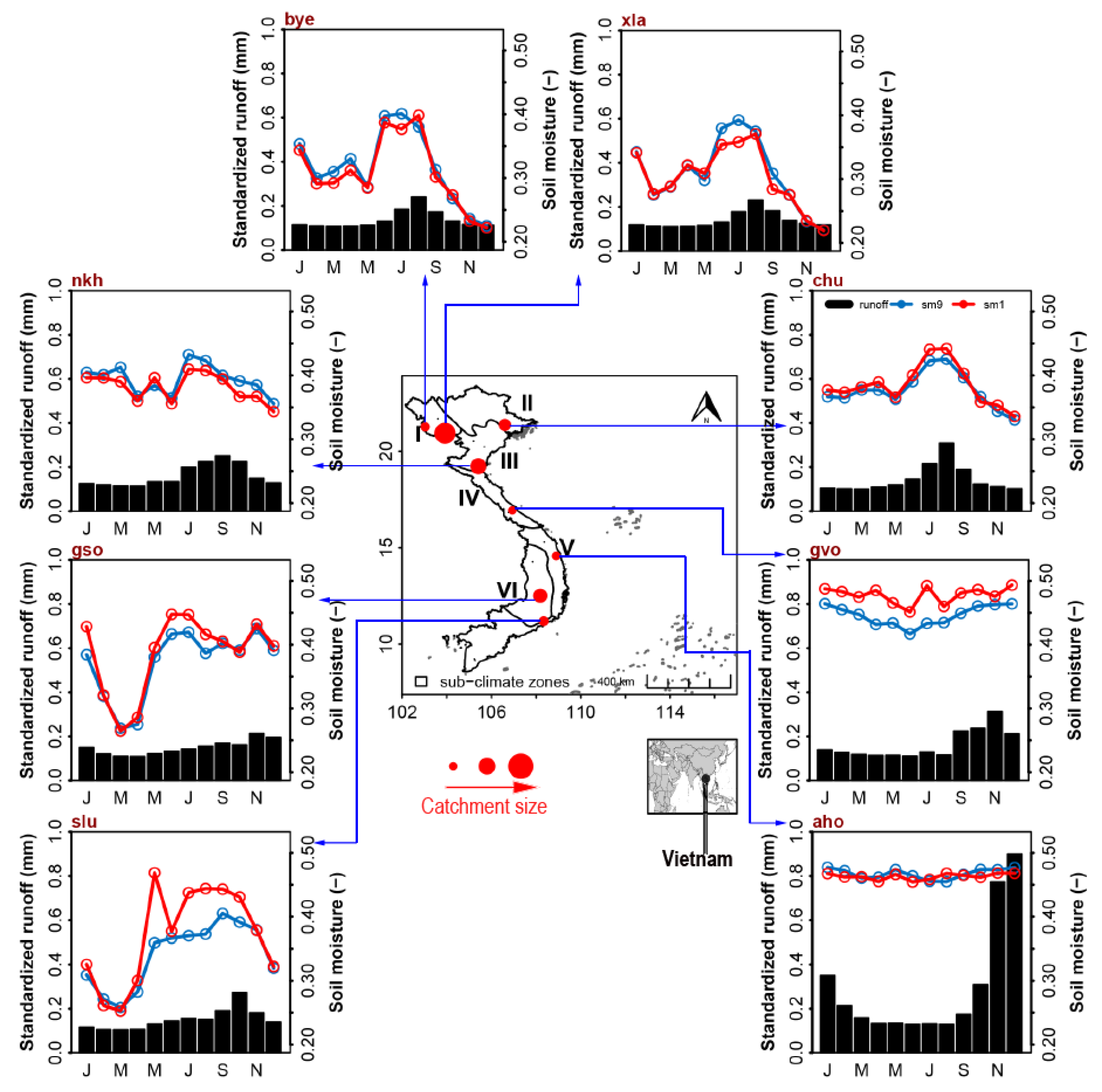
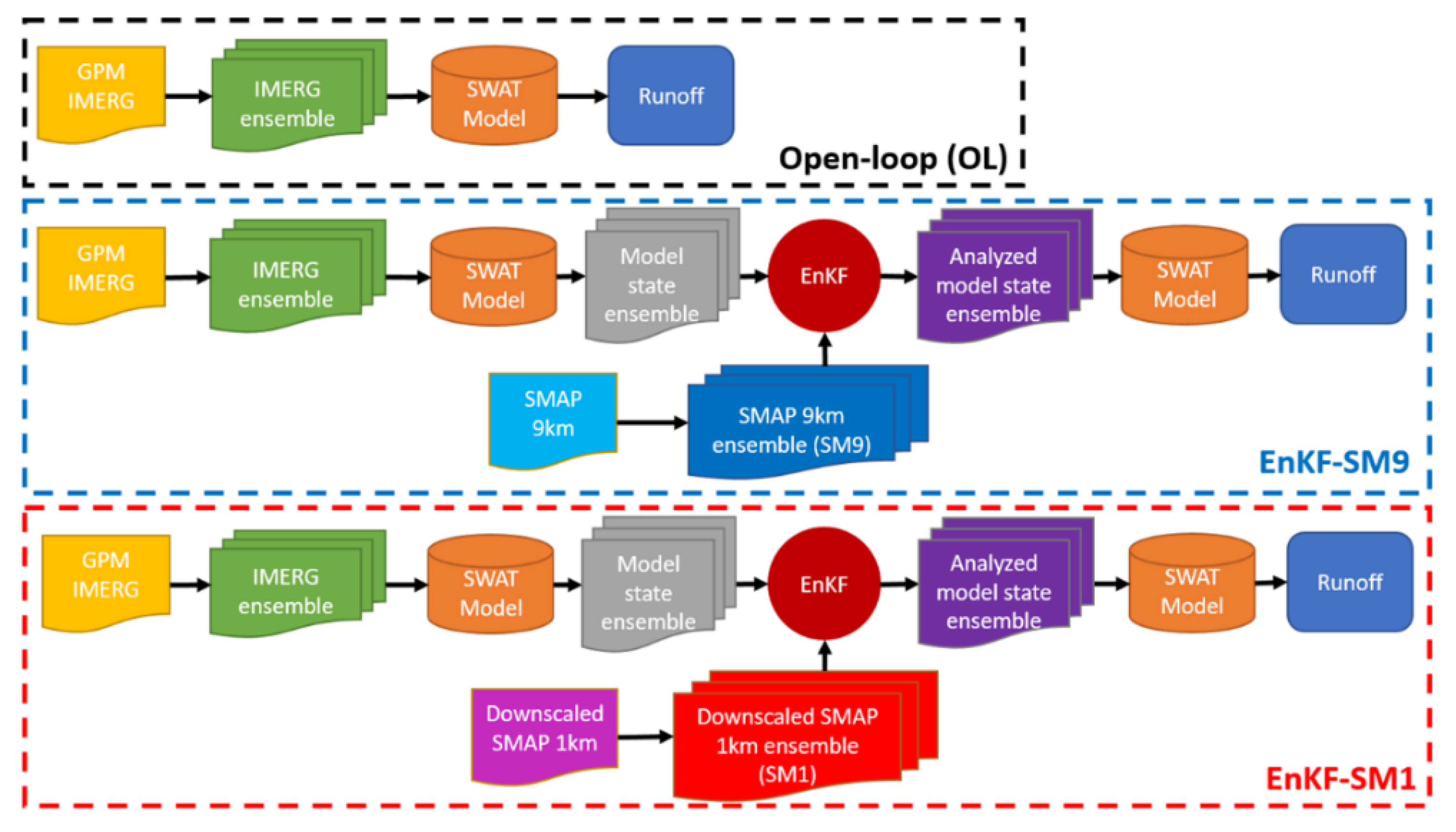
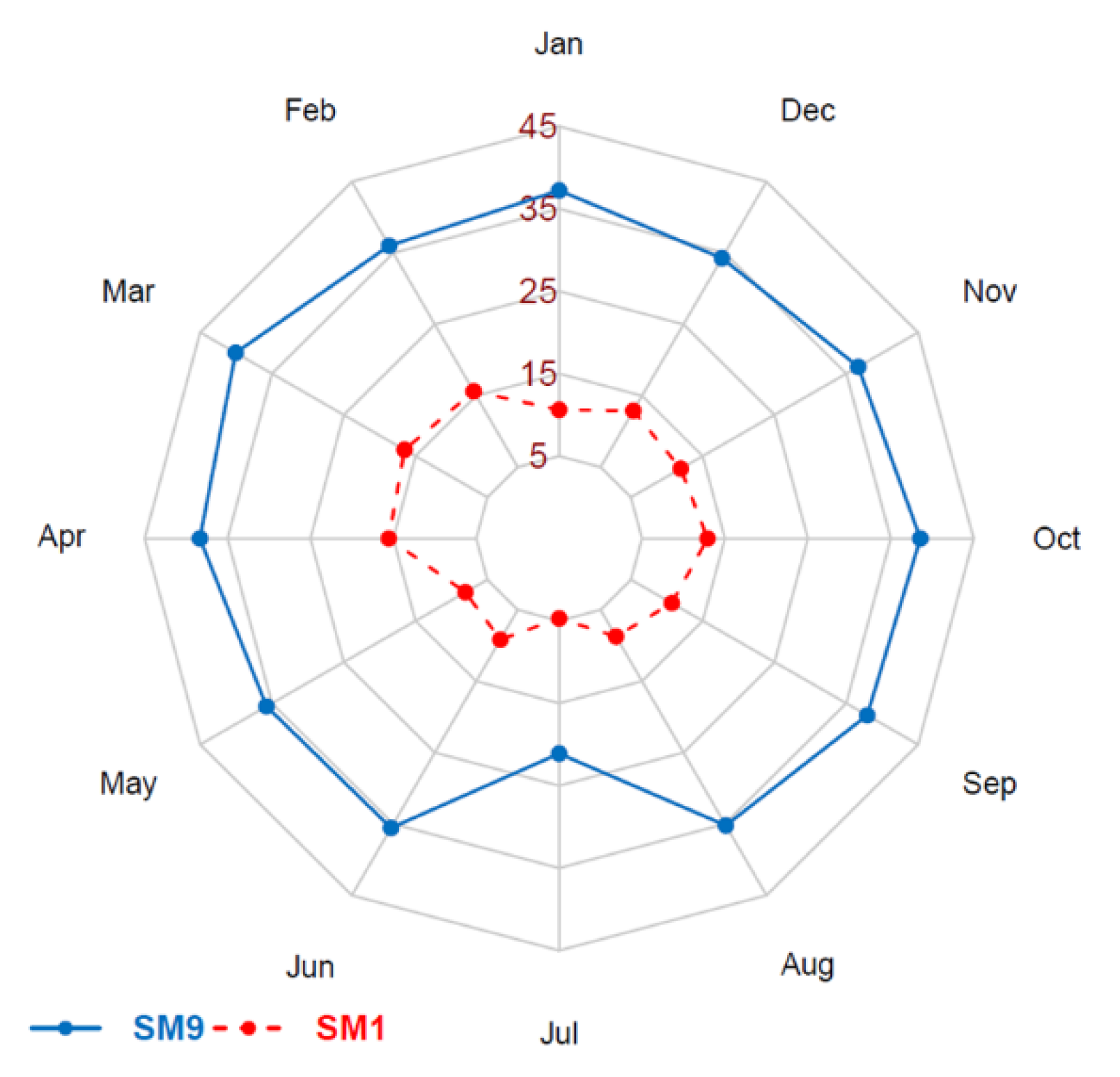
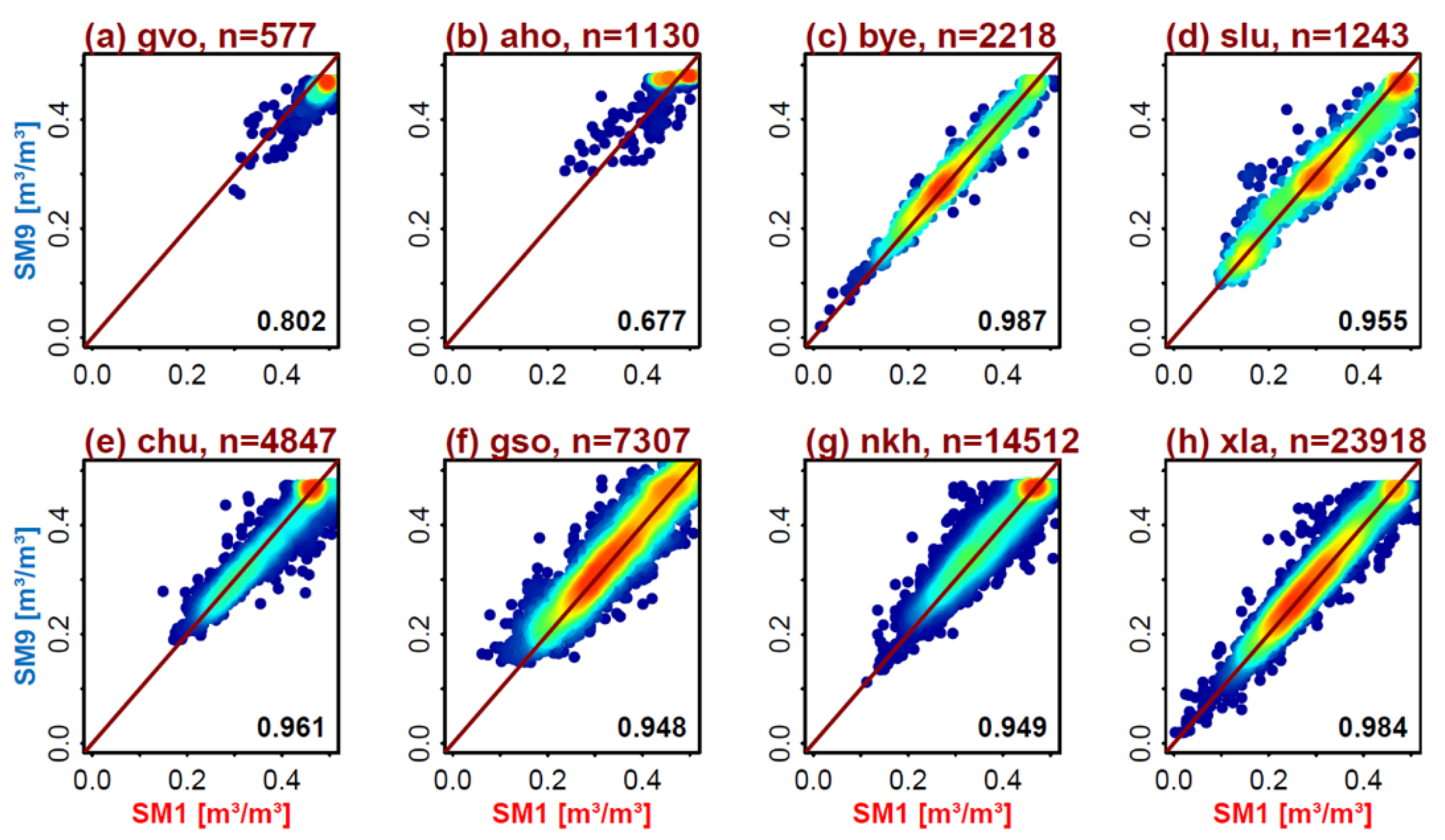
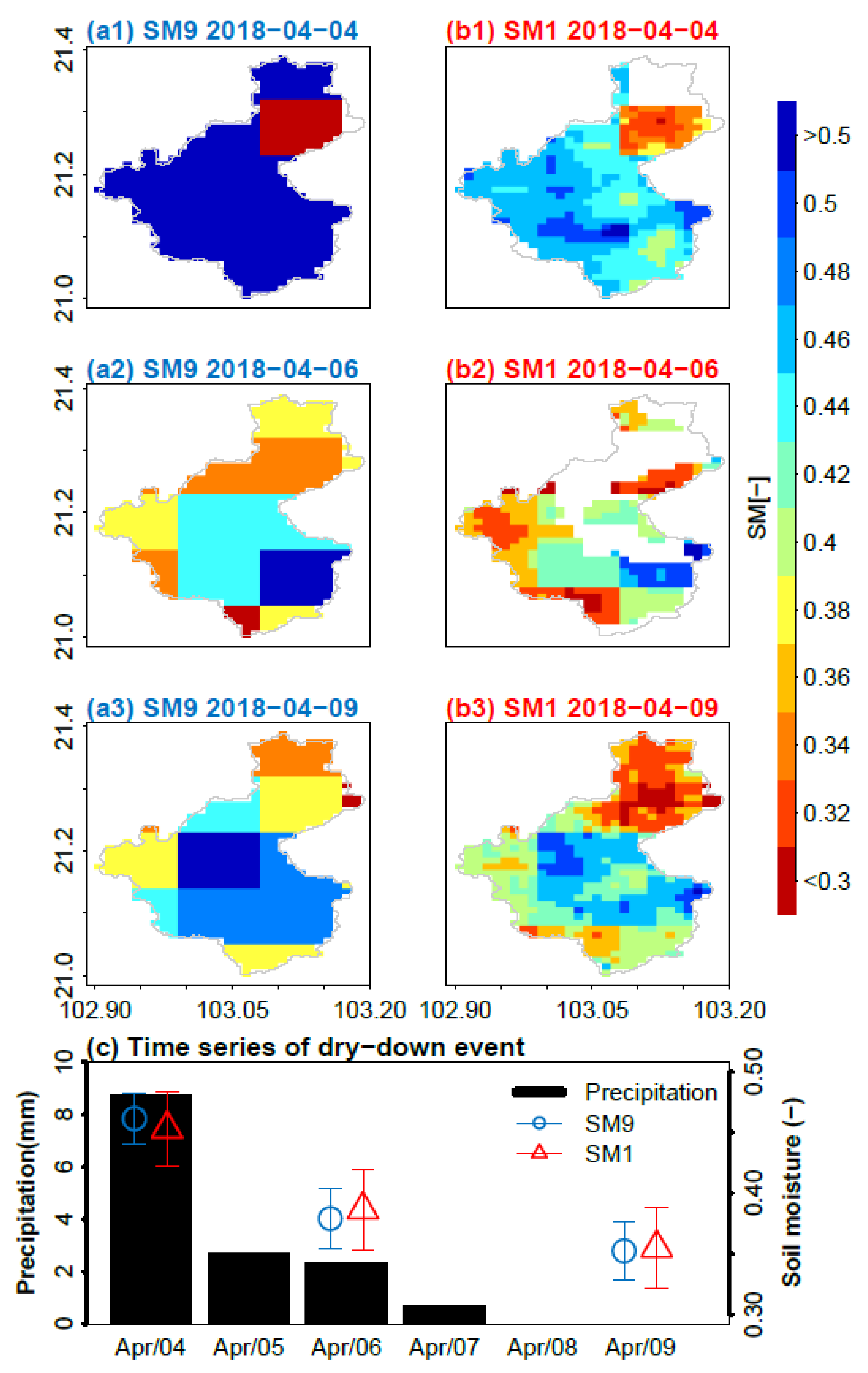

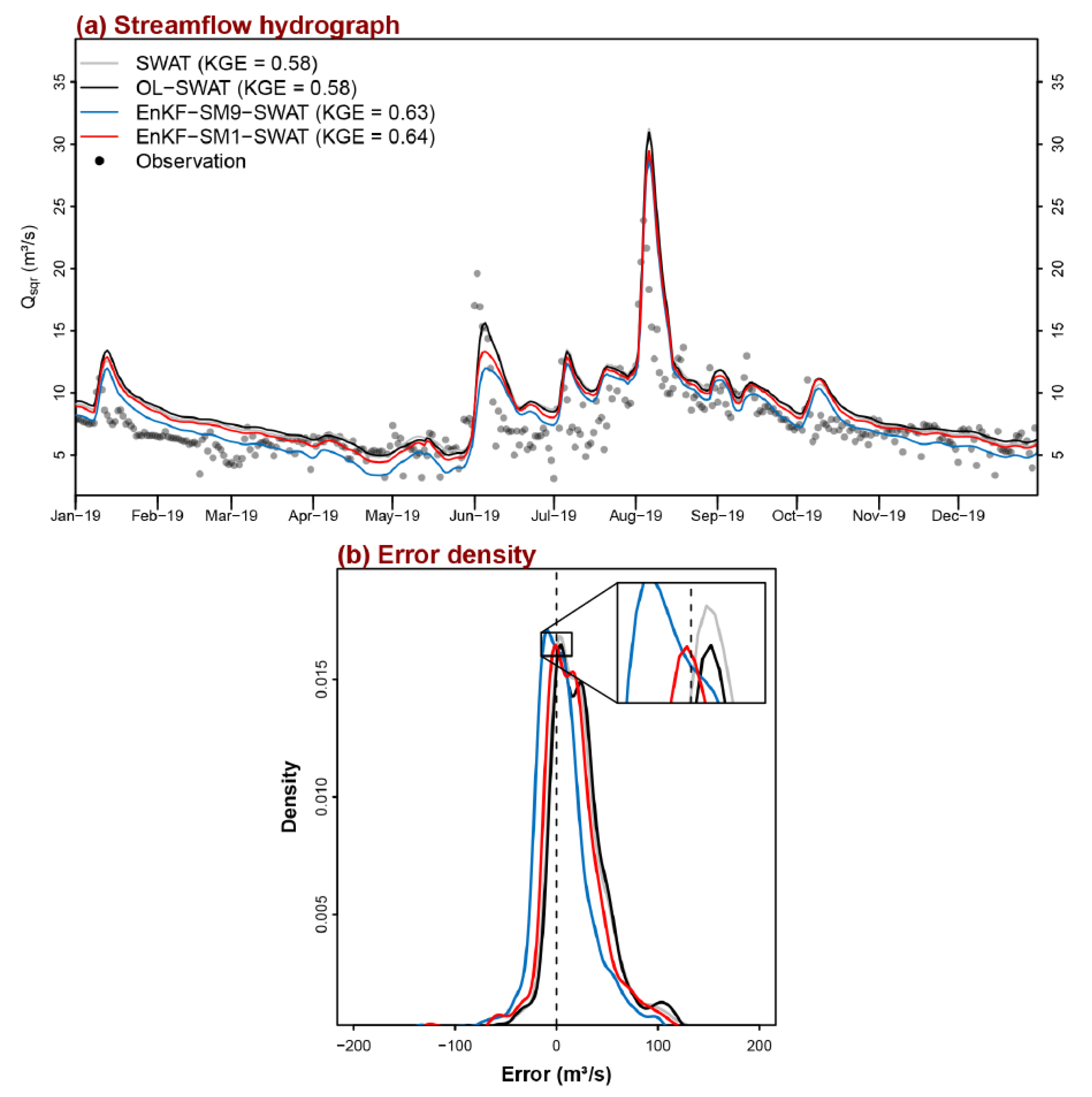
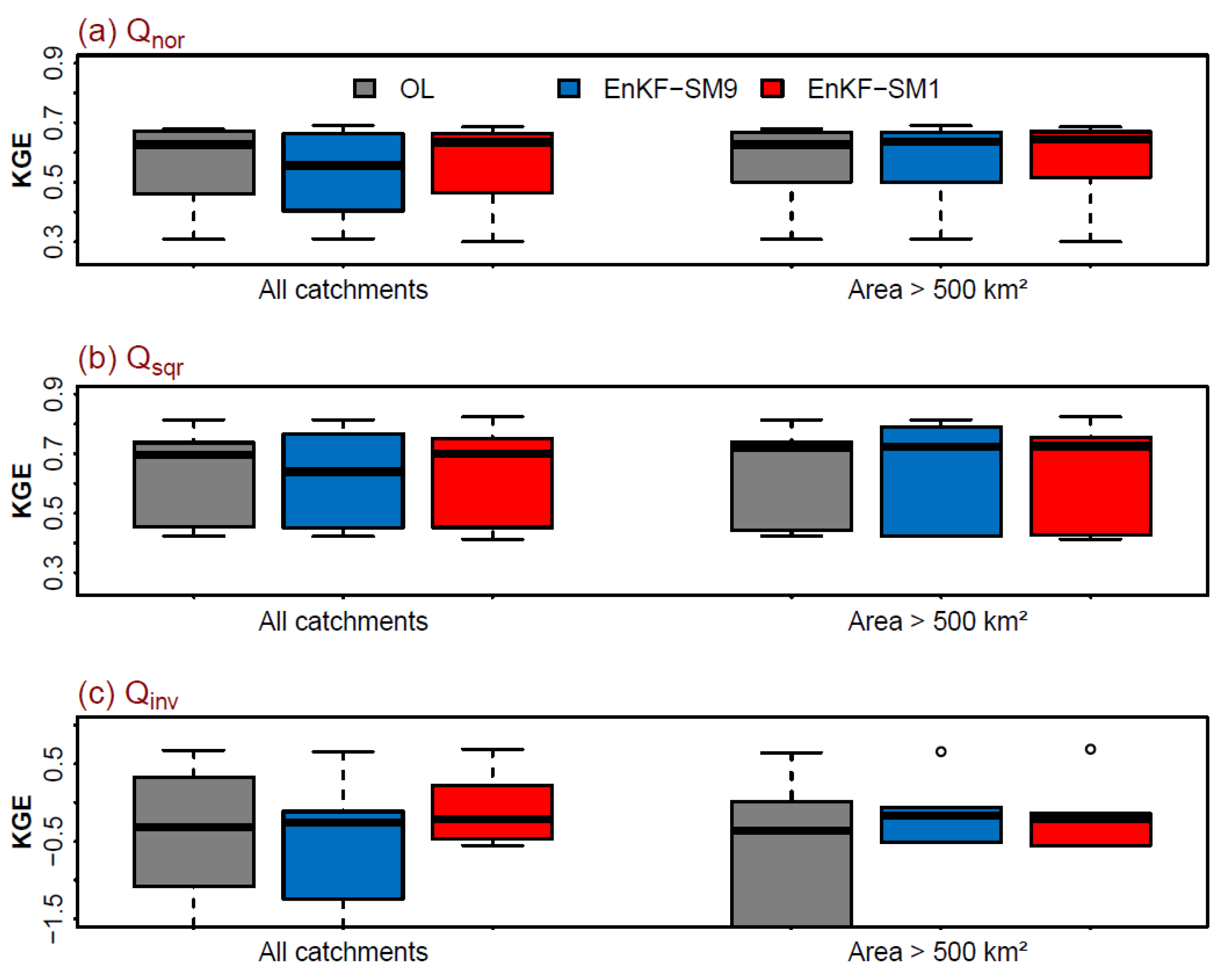
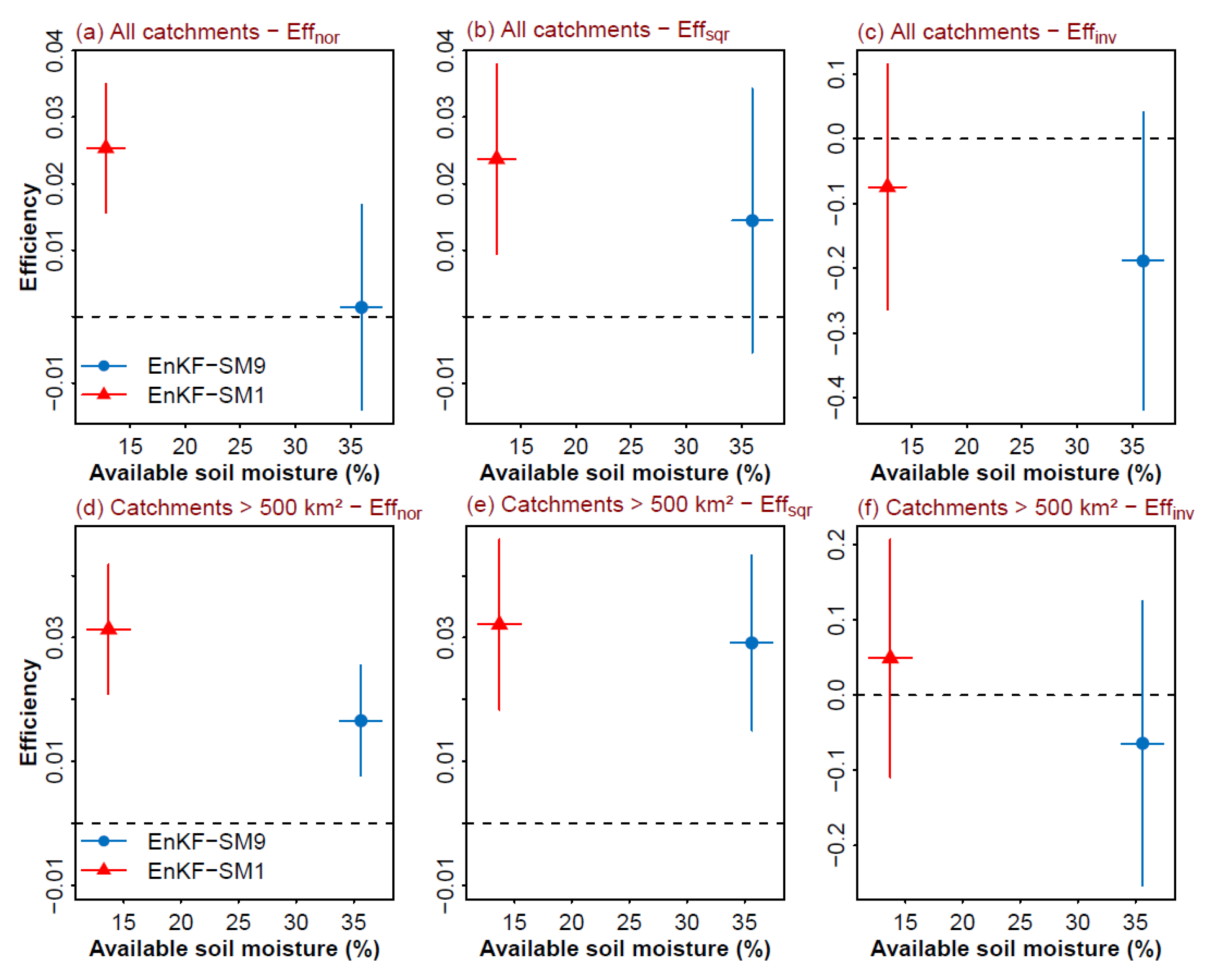
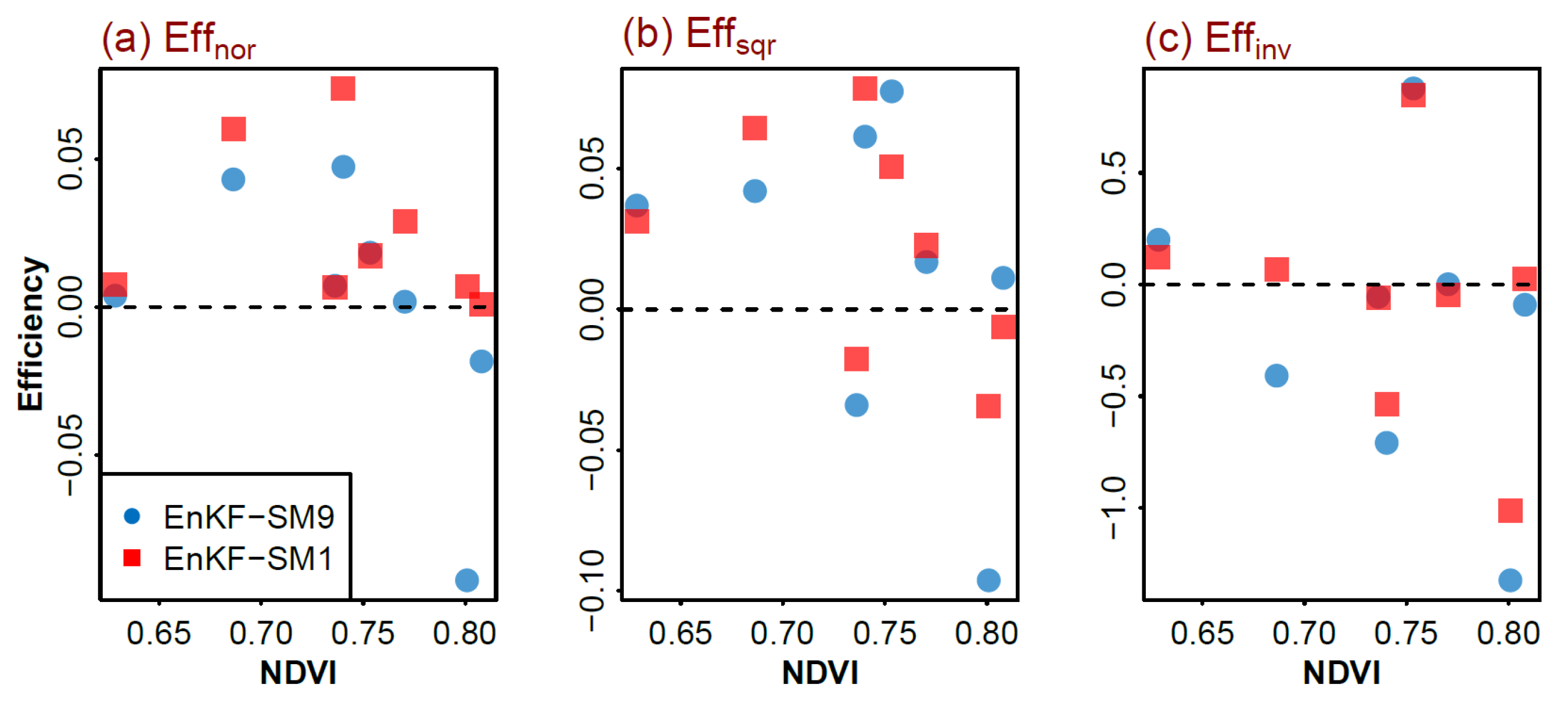
| Full Name | Short Name | Long. | Lat. | Area | Min | Median | Mean | Max | NDVI | SM9 | SM1 |
|---|---|---|---|---|---|---|---|---|---|---|---|
| (Degree) | (Degree) | (km2) | (mm/d) | (mm/d) | (mm/d) | (mm/d) | (-) | (%) | (%) | ||
| Giavong | gvo | 106.93 | 16.93 | 267 | 0.09 | 0.91 | 2.49 | 136.56 | 0.801 | 42.37 | 9.68 |
| Anhoa | aho | 108.90 | 14.57 | 383 | 0.36 | 1.87 | 7.54 | 254.91 | 0.628 | 31.78 | 10.41 |
| Banyen | bye | 103.03 | 21.27 | 638 | 0.21 | 0.65 | 1.51 | 33.04 | 0.740 | 42.56 | 21.46 |
| Songluy | slu | 108.34 | 11.19 | 964 | 0.04 | 0.51 | 2.02 | 42.30 | 0.808 | 41.74 | 5.84 |
| Chu | chu | 106.60 | 21.37 | 2090 | 0.02 | 0.25 | 1.79 | 99.22 | 0.736 | 31.78 | 12.24 |
| Giangson | gso | 108.19 | 12.51 | 3100 | 0.18 | 1.28 | 1.95 | 28.71 | 0.753 | 31.78 | 11.6 |
| Nghiakhanh | nkh | 105.41 | 19.22 | 4024 | 0.32 | 1.16 | 2.39 | 92.11 | 0.770 | 31.78 | 14.52 |
| Xala | xla | 103.92 | 20.94 | 6430 | 0.13 | 0.89 | 1.64 | 24.72 | 0.686 | 34.16 | 16.62 |
| Attributes | Data Type | Description | Period(s)/ Resolution | Sources |
|---|---|---|---|---|
| Climatic data | Precipitation | IMERG Final Run V6 | 2011–2019/0.10° | [56] |
| Max-, min- air temperature | CFSR vs2 | 2011–2019/0.25° | [60] | |
| Catchment attributes | Land use land cover | MCD12Q1 | 2016/500 m | [69] |
| Soil | HWSD | -/1 km | [70] | |
| Digital Elevation Model | HydroSHEDS | -/90 m (3 s) | [67] | |
| Data assimilation variable | Soil moisture | SMAP | 2015–2019/9-km | [12] |
| Soil moisture | Downscaled SMAP | 2015–2019/1-km | [33] | |
| Ground data | Streamflow | Eight hydrological stations | 2013–2019 | VMHA * |
| Station Name | Calibration (2013–16) | Validation (2017–19) | ||||
|---|---|---|---|---|---|---|
| KGE_nor | KGE_sqr | KGE_inv | KGE_nor | KGE_sqr | KGE_inv | |
| gvo | 0.623 | 0.703 | 0.413 | 0.670 | 0.686 | 0.674 |
| aho | 0.486 | 0.613 | −0.984 | 0.417 | 0.462 | −0.382 |
| bye | 0.786 | 0.864 | 0.176 | 0.575 | 0.796 | 0.259 |
| slu | 0.334 | 0.598 | 0.419 | 0.303 | 0.410 | −0.089 |
| chu | 0.611 | 0.312 | −2.708 | 0.694 | 0.470 | −1.774 |
| gso | 0.757 | 0.718 | −2.727 | 0.639 | 0.704 | −0.977 |
| nkh | 0.542 | 0.700 | −0.701 | 0.513 | 0.788 | −0.082 |
| xla | 0.698 | 0.786 | 0.479 | 0.681 | 0.750 | 0.650 |
| median | 0.617 | 0.702 | −0.263 | 0.607 | 0.695 | −0.086 |
Publisher’s Note: MDPI stays neutral with regard to jurisdictional claims in published maps and institutional affiliations. |
© 2022 by the authors. Licensee MDPI, Basel, Switzerland. This article is an open access article distributed under the terms and conditions of the Creative Commons Attribution (CC BY) license (https://creativecommons.org/licenses/by/4.0/).
Share and Cite
Le, M.-H.; Nguyen, B.Q.; Pham, H.T.; Patil, A.; Do, H.X.; Ramsankaran, R.; Bolten, J.D.; Lakshmi, V. Assimilation of SMAP Products for Improving Streamflow Simulations over Tropical Climate Region—Is Spatial Information More Important Than Temporal Information? Remote Sens. 2022, 14, 1607. https://doi.org/10.3390/rs14071607
Le M-H, Nguyen BQ, Pham HT, Patil A, Do HX, Ramsankaran R, Bolten JD, Lakshmi V. Assimilation of SMAP Products for Improving Streamflow Simulations over Tropical Climate Region—Is Spatial Information More Important Than Temporal Information? Remote Sensing. 2022; 14(7):1607. https://doi.org/10.3390/rs14071607
Chicago/Turabian StyleLe, Manh-Hung, Binh Quang Nguyen, Hung T. Pham, Amol Patil, Hong Xuan Do, RAAJ Ramsankaran, John D. Bolten, and Venkataraman Lakshmi. 2022. "Assimilation of SMAP Products for Improving Streamflow Simulations over Tropical Climate Region—Is Spatial Information More Important Than Temporal Information?" Remote Sensing 14, no. 7: 1607. https://doi.org/10.3390/rs14071607
APA StyleLe, M.-H., Nguyen, B. Q., Pham, H. T., Patil, A., Do, H. X., Ramsankaran, R., Bolten, J. D., & Lakshmi, V. (2022). Assimilation of SMAP Products for Improving Streamflow Simulations over Tropical Climate Region—Is Spatial Information More Important Than Temporal Information? Remote Sensing, 14(7), 1607. https://doi.org/10.3390/rs14071607








